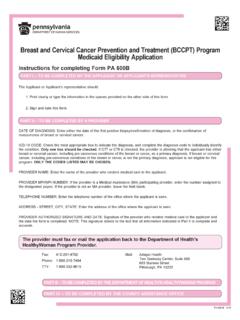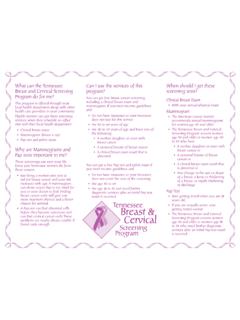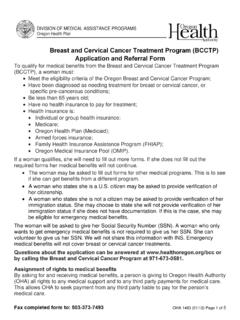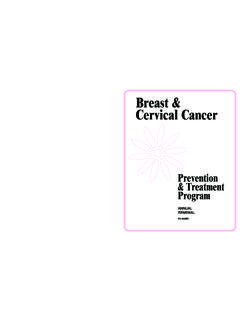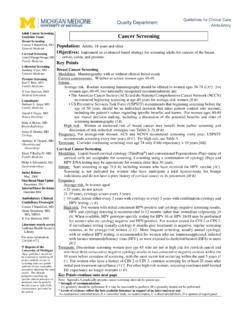Transcription of Guidelines for breast, cervical, and colorectal cancer ...
1 Guidelines for breast , cervical , and colorectal cancer screening FOR PRIMARY CARE PROVIDERS. 09/09. When anit Comes to cancer , ounce of prevention and screening is worth more than a pound of cure.. Prepared for the Waterloo Wellington Regional cancer Program by Red Door Wordsmithing Adapted with permission from cancer Care Ontario's Spotlight on: breast , cervical and colorectal Screening presentation. February 3, 2011. First printing June 2011. 05. Table of contents cancer Care 06. The role of primary 07. Screening Evaluating screening 09. Screening for breast , cervical , and colorectal 11. Spotlight on breast cancer screening Risk of getting breast 15. breast cancer screening 15. Ontario breast Screening 16. Challenges and 17. Clinical case study 17. Clinical case study 18.
2 breast cancer screening 18. Spotlight on cervical cancer screening Risk of getting cervical 23. (i) General 23. (ii) The role of HPV as a necessary 23. (iii) HPV 24. cervical cancer screening 25. Ontario cervical Screening 26. Challenges and 26. Clinical case study 27. Clinical case study 28. Clinical case study 28. cervical cancer screening 29. Spotlight on colorectal cancer screening Risk of getting colorectal cancer (i) General 35. (ii) Adenoma-carcinoma 35. (iii) The significance of colorectal cancer location (subsite).. 35. colorectal cancer screening 36. 37. Challenges and 38. Clinical case study 38. Clinical case study 39. colorectal cancer screening 39. 3. Introduction Introduction "To practice primary care well, we need to be experts in managing complexity.
3 I heard a colleague say this recently, and remarked on how true it is. Our patients come to us with many different issues, often with multifactorial causes. These issues need to be managed in the context of our patients' other illnesses, their world views on medicine and healing, and socioeconomic considerations such as whether they can afford or be motivated to consider a particular treatment. We have some help managing this complexity. For some time there have been excellent reference handbooks available on infectious disease protocols, immunization evidence, and multiple other areas of family medicine. At the Waterloo Wellington Regional cancer Program, we decided it was time to add one further handbook. This one is an effort to assist you by reducing the complexity surrounding screening for cancer .
4 We know that screening saves lives. We know that when some cancers are caught early in the disease process, the outcome is dramatically altered. Treatment is simpler, and more effective. Screening is an essential part of every primary care practice, and should be carried out in a systematic way. Nonetheless, cancer screening is not straightforward. It does not offer certainty. There are false positives, and false negatives. Evidence continues to accumulate and shift, regarding which screening method is most appropriate, for which age group, under which circumstances. This handbook is a best effort to collate and interpret the standards of care for cancer screening, as they now stand. There are clear standards for breast , cervical , and colorectal cancer nad so we're presenting those in this booklet.
5 It is an evidence-based approach, taking latest statistics, research, and policy from cancer Care Ontario and around the world. We hope it helps to make your job simpler, and helps to make you a more effective clinician. Sophie Wilson, MD, CCFP. Regional Primary Care Lead Waterloo Wellington Regional cancer Program 5. cancer Care Ontario cancer Care Ontario cancer Care Ontario (CCO) is the provincial government's cancer advisor. CCO is the agency responsible for continually improving services to ensure that patients receive the right care, at the right time, from the right person, in the right place, at every step of their journey with cancer . CCO's Ontario cancer Plan III outlines steps to provide Ontarians with the best cancer prevention, screening, and care.
6 This plan is structured around six goals spanning the full range of cancer care: 1. Help Ontarians lessen their risk of developing cancer . 2. Reduce the impact of cancer through effective screening and earlier detection. 3. Ensure timely access to effective diagnosis and safe, high-quality care. 4. Improve the patient experience along every step of the cancer journey. 5. Improve the performance of Ontario's cancer system. 6. Strengthen Ontario's ability to improve cancer control through research. CCO developed its Integrated cancer Screening (ICS) strategy to facilitate the delivery of consistent and coordinated screening to primary care givers and patients. The key elements of the ICS strategy are outlined below: 1. Increase patient participation in screening patient invitations and reminders patient supports and health-risk assessments targeted community-based outreach programs 2.
7 Increase primary care provider performance in screening screening prompts and exception reports feedback on screening performance and change management change management tools and training 3. Establish a high-quality integrated screening strategy information management and information technology infrastructure system performance monitoring and evaluation quality standards 6. The CCO has three distinct screening programs: the Ontario breast The role of primary care Screening Program, the Ontario cervical Screening Program, and ColonCancerCheck. The ICS strategy, together with these three screening programs, reflects CCO's commitment to reduce the impact of breast , cervical , and colorectal cancers by facilitating effective screening and earlier detection. The role of primary care The pivotal role of primary care in reducing the incidence of cancer and improving cancer care across the cancer continuum is widely ,2.
8 CCO created the Primary Care and cancer Engagement Strategy in 2008. Under this program, primary care leads are recruited from each of CCO's regional cancer programs across the province. These leads give primary care providers a voice in the cancer care system and the cancer care system a closer connection to primary care providers. Reducing the impact of cancer through effective screening and earlier detection is one of CCO's key goals. Primary care providers oversee and influence the health and well-being of a significant portion of Ontario's population. They can play an important role in screening intervention by: systematically conducting patient risk assessments and recommending appropriate screening based on evidence, Guidelines , and patient history managing the follow-up of abnormal screening test results Research shows that decisions to screen are strongly associated with recommendations from trusted primary care ,4.
9 7. Primary care references The Role of Primary Care 1. Blackwell DL, Martinez ME, Gentleman JF. Women's compliance with public health Guidelines for mammograms and Pap tests in Canada and the United States: an analysis of data from the Joint Canada/United States Survey of Health. Women's Health Issues. 2008 Mar;18(2):85-99. 2. Poole B, Black C, Gelmon K, Kan L. Is Canadian women's breast cancer screening behaviour associated with having a family doctor? Can Fam Physician. 2010 Apr;56(4):e150-7. 3. Zarychanski R, Chen Y, Bernstein CN, H bert PC. Frequency of colorectal cancer screening and the impact of family physicians on screening behaviour. CMAJ. 2007 Sep 11;177(6):593-7. 4. Zajac IT, Whibley AH, Cole SR, Byrne D, Guy J, Morcom J, et al. Endorsement by the primary care practitioner consistently improves participation in screening for colorectal cancer : a longitudinal analysis.
10 J Med Screen. 2010;17(1):19-24. 8. Screening Screening Evaluating screening procedures Screening refers to the application of tests, examinations, or other procedures to asymptomatic target populations in order to distinguish between those who may have a disease and those who probably do In 1968, the World Health Organization published the following guide- lines outlining the principles of screening: 1. The condition should be an important health problem. 2. There should be a treatment for the condition. 3. Facilities for diagnosis and treatment should be available. 4. There should be a latent stage of the disease. 5. There should be a test or examination for the condition. 6. The test should be acceptable to the population. 7. The natural history of the disease should be adequately understood.



